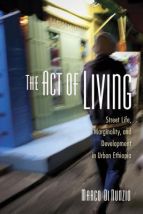The Act of Living: Street Life, Marginality, and Development in Urban Ethiopia

The Act of Living is a life study of two men, 49-year-old Haile and 39-year-old Ibrahim, from Arada, Addis Ababa. Haile and Ibrahim grew up “in secure poverty”, in circumstances that meant they spent plenty of time on the streets from a young age. Haile’s mother was a sex worker who worked out of their home, for instance, and as a teenager Haile worked outside selling potatoes and chewing gum. He went on to manage a video house (where films were screened informally) before being imprisoned for showing pornographic films. Neither Haile nor Ibrahim completed secondary school.
Author Marco Di Nunzio recounts how their marginality has been shaped by broader forces in the city, notably widening inequality as Ethiopia has seen increasing pockets of wealth. As Di Nunzio writes, “The Act of Living explores why people like Haile and Ibrahim were not empowered by economic growth and how they understood and acted on the endurance of their condition of marginality in a time of promise” (page 2). Their marginality is not accidental, but part and parcel of Ethiopia’s economic growth.
And the savvy hustler’s lifestyle that they adopted in response – which Di Nunzio calls “smartness” – helped to mitigate but not entirely eliminate the effects of such marginality. This included work in the street economy that sometimes shaded over into street violence, which provided both money and psychological benefits: “Street life gave marginalized young men a way of asserting their presence in the city while obtaining a certain degree of respect, recognition, and fame on the streets and in the community” (page 59). The street smartness of Ibrahim and Haile was particularly visible because so much of their informal employment and resistance to party politics, or incorporation within it, revolved around the street.
Clearly, this is a particularly male version of Ethiopian street life, and Di Nunzio acknowledges the ethnographic and cultural difficulties of incorporating female perspectives. But as a people-focused analysis of certain hardscrabble lives in Addis Ababa, The Act of Living is an interesting work of urban anthropology.
Further reading:
Brown, Alison, Nezar Kafafy and Adnane Hayder (2017), “Street trading in the shadows of the Arab Spring”, Environment and Urbanization Vol 29, No 1, pages 283–298, available at https://journals.sagepub.com/doi/full/10.1177/0956247816673559.
Malone, Karen (2002), “Street life: youth, culture and competing uses of public space”, Environment and Urbanization Vol 14, No 2, pages 157–168, available at https://journals.sagepub.com/doi/pdf/10.1177/095624780201400213.
Tolossa, Degefa (2010), “Some realities of the urban poor and their food security situations: a case study of Berta Gibi and Gemechu Safar in the city of Addis Ababa, Ethiopia”, Environment and Urbanization Vol 22, No 1, pages 179–198, available at https://journals.sagepub.com/doi/pdf/10.1177/0956247810363527.
Book note prepared by Christine Ro
Search the Book notes database
Our Book notes database contains details and summaries of all the publications included in Book notes since 1993 - with details on how to obtain/download.
Use the search form above, or visit the Book notes landing page for more options and latest content.
For a searchable database for papers in Environment and Urbanization, go to http://eau.sagepub.com/

